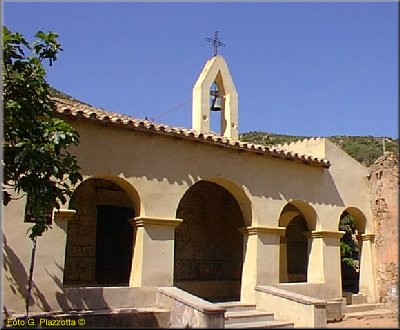 |
St. Barbara church by Ignazio Lecca |
![]()
The St. Barbara Church, according to the text written on
the marble plaque walled up at the entrance of the church, was erected in 1281 by Gallo,
archbishop of Cagliari, who it is said had lived in that locality, with other companions,
as a hermit monk.
Here is the text of the plaque, in accordance with the Casini and Bonfant's
reading:
AD HONOREM.DEI.ET.BEATE BARBARE.MARTIRIS:PreSENS.ECClesIA.EST CONTSrVCTA.SVB.ANNO DOmiNICE INCARNATIONIS.M.CC.LXXX.I INDICCIONE.VII.DomiNO GALLO KaLLARitane.ECCLesIE.PreSvLI.RESIDENTE EG.FRatrEGUANTINO.HMIGA.PreFATUM LOCUM.COHEREMITAS.SUOS. EODEM.TEMPORE.GUBERNATORE.
 The church is rectangular shape, as probably the archbishop
Gallo designed it to be built. It is still possible to notice the Romanesque architectural
motifs in the wall where the entrance of the temple opened, as well as in the lateral
wall. Such motifs date back to the thirteenth century. Subsequent interventions, in 1739,
caused reshaping and, maybe, the erections of the basin-shaped dome that, however,
according to some historians, dates back to the same period of the aisle. A portico in the
front, from the seventeenth century, carry a sail-shaped bell tower. Other maintenance
interventions, though useful, have partially disfigured the original arrangement of the
little church. In the several plaques on the wall of the church we have a proof of the
various recasting works. The characteristic motifs of the thirteen century nevertheless
remain clearly recognisable.
The church is rectangular shape, as probably the archbishop
Gallo designed it to be built. It is still possible to notice the Romanesque architectural
motifs in the wall where the entrance of the temple opened, as well as in the lateral
wall. Such motifs date back to the thirteenth century. Subsequent interventions, in 1739,
caused reshaping and, maybe, the erections of the basin-shaped dome that, however,
according to some historians, dates back to the same period of the aisle. A portico in the
front, from the seventeenth century, carry a sail-shaped bell tower. Other maintenance
interventions, though useful, have partially disfigured the original arrangement of the
little church. In the several plaques on the wall of the church we have a proof of the
various recasting works. The characteristic motifs of the thirteen century nevertheless
remain clearly recognisable.
In accordance with a document of 1355, issued by the Chancellery of King
Alfonso IV The Kind and found in the archives of the Crown of Aragon, the Basilian monks
asked the King of Aragon the concession of the St. Barbara Church "sita in
Cabuterra insula Sardinie". According to the hypothesis of O.Schiena, the church
was probably owned by the same Basilian monks in the High Middle Age.
In the eighteenth century the St. Barbara Church, formerly property of the
archbishop of Cagliari, was transferred to the Minori Conventuali friars in exchange of
the St. Maria Church in Uta. Tommaso Polla, friar of mythical penitence, took possession
of the St. Barbara Church with other friars. He was called by the inhabitants of Capoterra
cure souls in the absence of other parish priests, contracted malignant fever and died in
Cagliari on September 29th 1663 in the odour of sanctity.
The St. Barbara feast is celebrated at the end of June. This saint isn't
the Saint Barbara of Nicomedia but should be, according to the tradition, a Christian
martyr from Cagliari, who lived for 30 years. Her mortal remains were discovered in St.
Restituta sepulchre on June 23rd 1620, according to what Serafini Esquirro wrote in 1624
in "Santuario de Caller, y verdadera historia de la invencion de los cuerpos
santos hallados en la dicha ciudad y su ar�obiscobado".
S.BARBARA V.ET M.Q.VIXIT ANNIS XXX (Santa Barbara Virgo et Martir, quae vixit annis triginta)
In this way J.F. Carmona in "Alabancas de los santos de
Sarde�a" in 1631 reports the text of the plaque found on the tomb of the saint.
The most complete biography of St. Barbara is given by Bonfant who, in his "Triumpho
de los Santos del Renyo de Cerde�a", reports of the origins of the saint born in
the city of Cagliari. She was a companion of St. Restituta, with whom she was arrested and
imprisoned because they were Christian. She was sentenced to be decapitated. In order to
avoid reactions of the prominent citizens she was taken to a mountain few miles distant
from the town and there the sentence was carried out. The place in the mountain, since
then, took the Sardinian name of Sa Scabizzada (the beheaded). Bonfant says
that in that place there was a dry spring from where water started to gush when the head
of the saint fell down. In memory of the prodigy the hermits who lived in the mountain
erected a chapel. The body of Saint Barbara was brought back to Cagliari by the Christians
to be buried in the St. Restituta cave.
In the St. Barbara hill, traditionally the place of the saint's beheading,
the "Sa Scabizzada" spring is of remarkable interest, distant a few yards from
the small church. Popular tradition has it that the faithful can ward off evil at this
spring. In the word of E.Atzori remember with these words: "The faithful that go
to the sanctuary, before drinking, put in one of the niches in the wall that protects the
spring, a little cross made with with a stick that joins another, through the split
created up to half of its length. Tradition says that if you drink without building the
rudimentary cross, you risk stumbling and hurting yourself on the way back".
![]()
